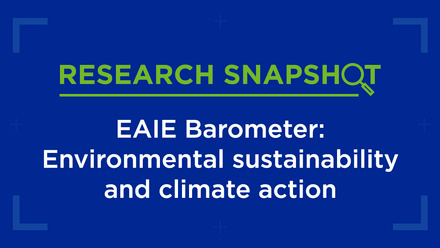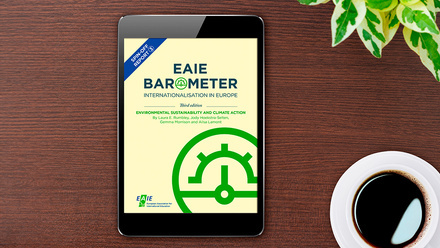Measuring environmental sustainability in international education

Global news brings more evidence of the impact of climate change each day, and this year more than ever. More than 70,000 delegates are about to converge in Dubai for COP28. It marks a milestone moment as they review commitments made under the 2015 Paris Agreement. At the same time, international educators are stepping up their own commitments, joining forces to measure and track climate action across the sector.
We all know international education is a force for good. We need students to travel across borders, to foster greater mutual understanding and to enrich the education experience for all. However, to demonstrate our commitment to climate action, we need to start to measure it, compare it, and track changes over time. Why? ‘What gets measured gets done’. Without hard data, real positive change can be hard to achieve. Experience tells us that external comparators drive better-informed institutional decision-making.
Aside from the obvious climate urgency, students, staff and stakeholders increasingly expect to see evidence of more than just a commitment to climate action. In the most recent studies, 82% of prospective international students say sustainability is an important factor in decision-making, 43% are actively researching universities’ environmental sustainability strategy and efforts and 32% cite climate action as one of their top concerns among the 17 UN Sustainable Development Goals.
Climate leadership begins at the top
In Australia and New Zealand a pilot study of the Climate Action Barometer™ (CAB) has identified a lack of resources, set targets and clear metrics as key challenges for embedding sustainability. This could be attributed to a general disconnect between international and university-wide strategies. Few universities have a dedicated climate or sustainability strategy that covers global operations. This presents a huge opportunity to fix the international education-shaped hole in the sustainability strategies of many universities. Or as Morten Overgaard, Director Office of International Education at DTU, says on the CAB website, "although we have a longstanding and clear commitment to international education as well as strong focus on sustainability – especially in research and education - we cannot claim that the two have been bridged yet. Our readiness to join forces with other European universities in CAB to measure what we are doing and share and compare best practice is an expression that we are aware that we should be ready to change."
The most important thing is getting started, because every action is a step in the right direction
Speaking of the same initiative, Jennifer Wilkinson, Director of Student Recruitment & Business Development of London Metropolitan University says "We are continually evaluating our efforts and looking for new ways to improve. Joining this initiative with other European universities will help us understand our impact more and work with the sector to develop solutions to some of the identified challenges."
Benchmarking climate literacy
Climate action begins with education and knowledge inspires action. Yet few institutions measure climate awareness or climate literacy among current staff. Some do provide opportunities for staff to engage in climate-related initiatives.
Climate literacy among incoming international students is equally important. Some universities now include sustainability information in orientation; a very small number require students to complete a climate literacy subject. A growing number offer programs related to the Sustainable Development Goals (SDGs) and incentivise academics to offer sustainability-themed global learning programs.
Paperless operations and sustainable procurement
Print collateral once reigned supreme in international marketing, but the days of shipping course guides across the globe are, surprisingly, all but gone. Most universities have substituted paper-based collateral with digital alternatives, at least to some extent. The vast majority of applications are now online. Taking the plunge to go completely paperless appears to be a little further off, with very few universities going fully digital in their international operations.
When it comes to procurement, there are many opportunities to improve practice. Assessing sustainability and commitment to climate action should be part of the criteria for evaluating potential study abroad partners, education agents and other third-party providers. This in turn will accelerate climate action and the pace of change in other countries.
The elephant in the room
Tracking student emissions is not yet common practice, but we are seeing the beginnings of a common means of measurement and internationally, an increasing requirement to report emissions data. Climate impact is generally not a determining factor for staff travel and conference attendance – although the most recent EAIE Conference was a great example of the Association leading the way for its members, with the #EAIEgreengoals initiative. Increasingly, universities have travel booking systems that provide emissions data, and a growing number incentivise train travel over flying, and economy over business class. Yet very few have an emissions reduction target for staff travel.
As Tim Field, from The University of Sydney says of the pilot, ‘The Climate Action Barometer presents our international team with the perfect opportunity to show leadership. Climate action and sustainability are, at heart, global issues so we need to be the ones driving change, measuring impact and shaping the future of the discourse on this subject as it pertains to us - for the benefit of our team, the University and the international education sector’.
So what’s holding us back? All universities in the pilot study anticipate that climate change will have a significant impact on international operations within 3–5 years. And many have already reported being affected by extreme weather events due to climate change. With all the will in the world, universities can be difficult places to instigate change. But the most important thing is getting started, because every action is a step in the right direction.






